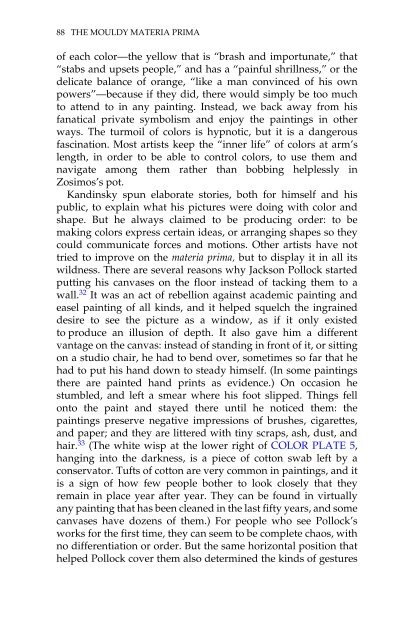What Painting Is: How to Think about Oil Painting ... - Victoria Vesna
What Painting Is: How to Think about Oil Painting ... - Victoria Vesna
What Painting Is: How to Think about Oil Painting ... - Victoria Vesna
You also want an ePaper? Increase the reach of your titles
YUMPU automatically turns print PDFs into web optimized ePapers that Google loves.
88 THE MOULDY MATERIA PRIMA<br />
of each color—the yellow that is “brash and importunate,” that<br />
“stabs and upsets people,” and has a “painful shrillness,” or the<br />
delicate balance of orange, “like a man convinced of his own<br />
powers”—because if they did, there would simply be <strong>to</strong>o much<br />
<strong>to</strong> attend <strong>to</strong> in any painting. Instead, we back away from his<br />
fanatical private symbolism and enjoy the paintings in other<br />
ways. The turmoil of colors is hypnotic, but it is a dangerous<br />
fascination. Most artists keep the “inner life” of colors at arm’s<br />
length, in order <strong>to</strong> be able <strong>to</strong> control colors, <strong>to</strong> use them and<br />
navigate among them rather than bobbing helplessly in<br />
Zosimos’s pot.<br />
Kandinsky spun elaborate s<strong>to</strong>ries, both for himself and his<br />
public, <strong>to</strong> explain what his pictures were doing with color and<br />
shape. But he always claimed <strong>to</strong> be producing order: <strong>to</strong> be<br />
making colors express certain ideas, or arranging shapes so they<br />
could communicate forces and motions. Other artists have not<br />
tried <strong>to</strong> improve on the materia prima, but <strong>to</strong> display it in all its<br />
wildness. There are several reasons why Jackson Pollock started<br />
putting his canvases on the floor instead of tacking them <strong>to</strong> a<br />
wall. 32 It was an act of rebellion against academic painting and<br />
easel painting of all kinds, and it helped squelch the ingrained<br />
desire <strong>to</strong> see the picture as a window, as if it only existed<br />
<strong>to</strong> produce an illusion of depth. It also gave him a different<br />
vantage on the canvas: instead of standing in front of it, or sitting<br />
on a studio chair, he had <strong>to</strong> bend over, sometimes so far that he<br />
had <strong>to</strong> put his hand down <strong>to</strong> steady himself. (In some paintings<br />
there are painted hand prints as evidence.) On occasion he<br />
stumbled, and left a smear where his foot slipped. Things fell<br />
on<strong>to</strong> the paint and stayed there until he noticed them: the<br />
paintings preserve negative impressions of brushes, cigarettes,<br />
and paper; and they are littered with tiny scraps, ash, dust, and<br />
hair. 33 (The white wisp at the lower right of COLOR PLATE 5,<br />
hanging in<strong>to</strong> the darkness, is a piece of cot<strong>to</strong>n swab left by a<br />
conserva<strong>to</strong>r. Tufts of cot<strong>to</strong>n are very common in paintings, and it<br />
is a sign of how few people bother <strong>to</strong> look closely that they<br />
remain in place year after year. They can be found in virtually<br />
any painting that has been cleaned in the last fifty years, and some<br />
canvases have dozens of them.) For people who see Pollock’s<br />
works for the first time, they can seem <strong>to</strong> be complete chaos, with<br />
no differentiation or order. But the same horizontal position that<br />
helped Pollock cover them also determined the kinds of gestures


